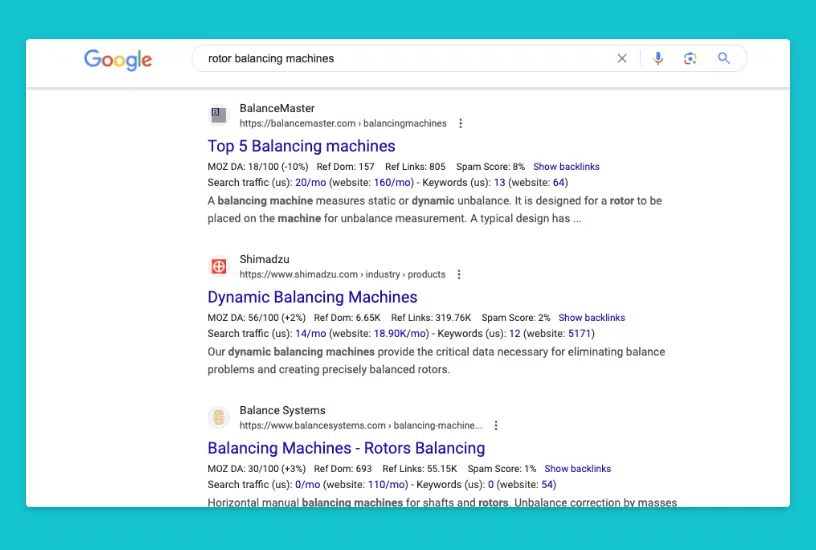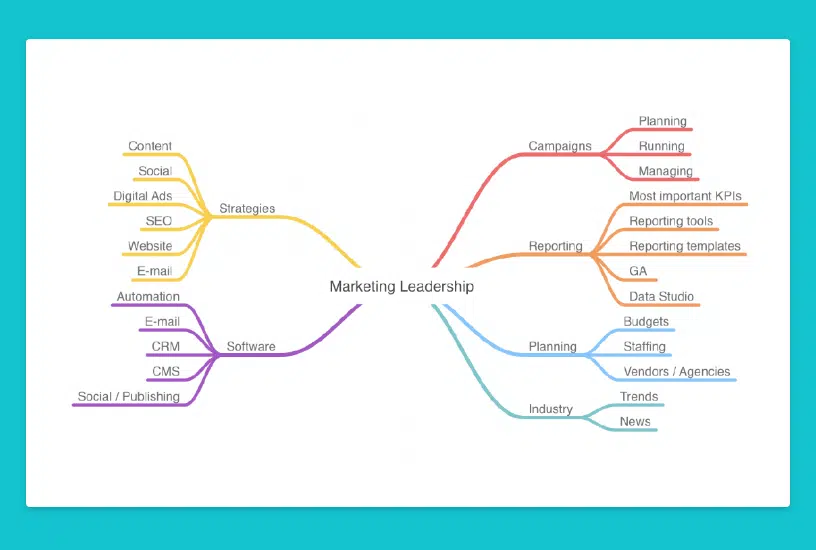Attract More Qualified Leads: SEO for Manufacturing Companies

Are you interested in leveraging your website to find more qualified leads? One of the most effective ways to do this is through an Search Engine Optimization (SEO) strategy.
Optimizing your website to align with the needs and preferences of your target audience gives manufacturers like you an important advantage. You enhance your company’s online visibility, connect with an audience who is actively seeking solutions within your industry, and funnel higher quality leads to your business.
Let’s discuss why SEO is a game-changer for those in the manufacturing industry as well as how SEO can help you generate leads and drive business growth.
What Is SEO?
SEO stands for Search Engine Optimization, which is the practice of optimizing a website to improve its visibility and ranking on search engine results pages (SERPs).
Through various techniques and strategies, businesses can be found more easily by search engines when their website’s relevance and authority is improved.

As a result, when users search for specific keywords or phrases related to their industry, their website is more likely to appear prominently in the search results, driving organic traffic and potential customers to their site.
Why SEO Is a Powerful Way to Attract New Business for Manufacturing Companies
You know how incredibly powerful the internet is for your business. Search engines are prt of the reason why. In fact, 81% of potential customers will search for options online before making a purchase decision.
So it’s easy to see how SEO will benefit you, we’ve listed how this marketing strategy can help your manufacturing business to obtain a competitive advantage in your market:
- Technical Nature of Target Audience: Manufacturing and industrial companies often cater to a highly technical and highly informed audience. Prospective clients engaged in research and problem-solving tend to rely heavily on search engines to find information, explore potential solutions, and evaluate companies before making decisions.
Through blogs, manufacturers can position themselves as authoritative sources and connect with potential clients during their crucial research phase.
- Low Competition: Surprisingly, many manufacturing and industrial companies have yet to fully embrace SEO, providing a relatively untapped opportunity for your organization to gain market share.
- Lead Generation Powerhouse: According to one survey, 59% of B2B marketers confirm that SEO strategies have a huge impact on their lead generation efforts. From the early research stages to the final decision-making process, a strong SEO presence ensures continuous brand visibility and engagement.
- High Conversion Rates: SEO strategies deliver higher closing rates than traditional outbound sales efforts. Studies show that the average closing rate for SEO-generated leads is 14.6%, while outbound sales conversion rates hover around a mere 1.7%.
This stark difference highlights the immense potential of SEO in driving qualified leads and maximizing conversion opportunities for your manufacturing business.
- Addressing Long Sales Cycles: Manufacturing and industrial companies deal with long sales cycles, characterized by intricate decision-making processes and multiple touchpoints. Leveraging SEO to establish a robust brand presence enables manufacturers to achieve three important goals:
- Maintain top-of-mind awareness among potential clients.
- Build trust and credibility.
- Influence purchase decisions.
How to Develop an Effective SEO Strategy
SEO is about more than just ensuring that your website ranks at the top of Google’s search engine results page.
When you also consider that SEO helps potential customers find their way to the right information, you will be more successful. Therefore, it’s critical that you focus on both the content of your site as well as its structure. In other words, carefully consider how visitors will interact with your site and what that experience will feel like for them. Here a just a few tips:
- Audit Your Website for SEO Barriers: Look for errors, broken links, duplicate content, and other technical issues that may impact your website’s visibility and ranking. Begin by conducting a comprehensive audit of your website to identify any potential barriers that may hinder search engine optimization.
Tools like Google Search Console and Screaming Frog can help you analyze if search engines are encountering issues while indexing your pages.
- Run Google PageSpeed Tests: Page loading speed is a priority in SEO for search engines. Slow-loading pages can negatively affect user experience and search engine rankings.
Utilize Google PageSpeed Insights or similar tools to assess the performance of your pages. Implement these recommended techniques, among others to improve page speed:
- Optimize images
- Leverage browser caching
- Minimize JavaScript and CSS files
- Ensure Your Website Has an XML Sitemap: An XML sitemap is a file that lists all the pages on your website, helping search engines understand its structure and content.
Ensure that you have a properly formatted XML sitemap and submit it to search engines like Google and Bing through their respective webmaster tools. This helps search engines crawl and index your pages more efficiently.
- Check Your robots.txt File: Review your robots.txt file to ensure that important pages are not being blocked from search engine crawlers.
Also, make sure that areas of your site you don’t want indexed, such as administrative sections or duplicate content, are properly blocked. Adjust the robots.txt file as necessary to optimize search engine visibility.
- Review Navigation and Internal Links: The navigation and internal linking structure of your website play a significant role in SEO.
Ensure that important pages are well-linked throughout your site, allowing both users and search engines to easily navigate and discover relevant content. Implement clear and descriptive anchor text for internal links, providing context and relevance to search engines.
Identify SEO Keywords and Phrases
Keyword research is a fundamental step in SEO. Search engines use these to identify what your content is about, and match them to the appropriate list of search results. Use tools like SEMRush, Moz, or Ahrefs to understand the specific terms and phrases your target customers are searching for.
Prioritize keywords based on factors, namely:
- Difficulty
- Search volume
- Search intent
- Commercial
- Transactional
- Navigational
- Informational

Focus on high-volume, low-difficulty keywords for best results as your top priority.
Optimize Existing Pages for Keyword Research
Review your existing website pages and identify those that align with your target keywords in terms of search intent and topic relevance.
Select one primary keyword per page, along with one or two variations to account for different search queries. Incorporate these keywords naturally into various elements of the page, including:
- Title and meta descriptions: Craft compelling, keyword-rich titles and meta descriptions that accurately describe the page’s content and entice users to click.
- URLs: Optimize URLs by including relevant keywords and making them user-friendly and easily readable.
- Headings: Structure your content with appropriate heading tags (H1, H2, etc.), incorporating relevant keywords where appropriate.
- Content: Create informative, engaging, and keyword-rich content that provides value to users while incorporating the target keywords naturally.
Create Content Around Your Core Topics and Keywords
To establish your website as a valuable resource in your industry and drive SEO, you must have high-quality content. And that content should focus on the right topics.

Follow these steps to get started:
- Identify the core topics or themes you are targeting. Each one must have a one main keyword it will focus on. However, to be optimize SEO, there should be multiple keywords related to a specific subject.
- Develop long-form, comprehensive articles that cover each sub-topic within the core theme. These articles should serve as pillars of information while incorporating relevant keywords naturally.
- Create individual articles that delve deeper into each sub-topic. Additional articles should provide more specific insights, examples, case studies, or practical tips. Inter-link these articles, creating a network of interconnected content that strengthens the relevance and authority of your website, and helps you rank higher on SEO.
Acquiring High-Value Links
Search engines view links as votes of confidence in your website and its content. Having a strong link profile is crucial for building authority and improving search engine rankings.
Aim to acquire links from high-authority websites such as:
- Industry publications
- News sites
- Reputable blogs
- Authoritative industry-specific websites
Seek out opportunities to contribute guest articles, be featured in interviews or case studies, or collaborate on content with influential individuals or organizations within your industry. These high-value links will enhance your website’s credibility and visibility in search engine results.
Tracking Progress
To gauge the effectiveness of your SEO efforts, it’s important to track and monitor your progress so you can adjust your approach. You’ll want to double down on what’s working and adjust course for strategies that aren’t delivering results.
Utilize tools like SEMRush, Moz, or aHrefs to analyze key metrics such as keyword rankings, organic traffic, backlinks, and overall website performance. By doing this, you’ll uncover the following insights:
into how your website is performing in search engine results, identify areas for improvement, and track the impact of your SEO strategies over time.
Summary: SEO for Manufacturers
SEO presents significant opportunities for manufacturing and industrial companies to grow their business and attract new clients. With the proper understanding of SEO, it’s possible to implement strategies and create valuable content that will improve online visibility, drive organic traffic, and establish your brand as an authority in the manufacturing industry.
Observe these practices for robust SEO efforts:
- Optimize your website.
- Target relevant keywords.
- Create comprehensive content.
- Acquire high-quality links.
- Track progress.
SEO is complex and time-consuming, requiring expertise as well as experience. If you need assistance with SEO implementation or strategy, contact 3.7 Designs and request a free SEO assessment to receive expert guidance tailored to your specific needs and goals.
Embracing SEO as a fundamental part of your digital marketing efforts can unlock immense growth opportunities for your manufacturing or industrial company.